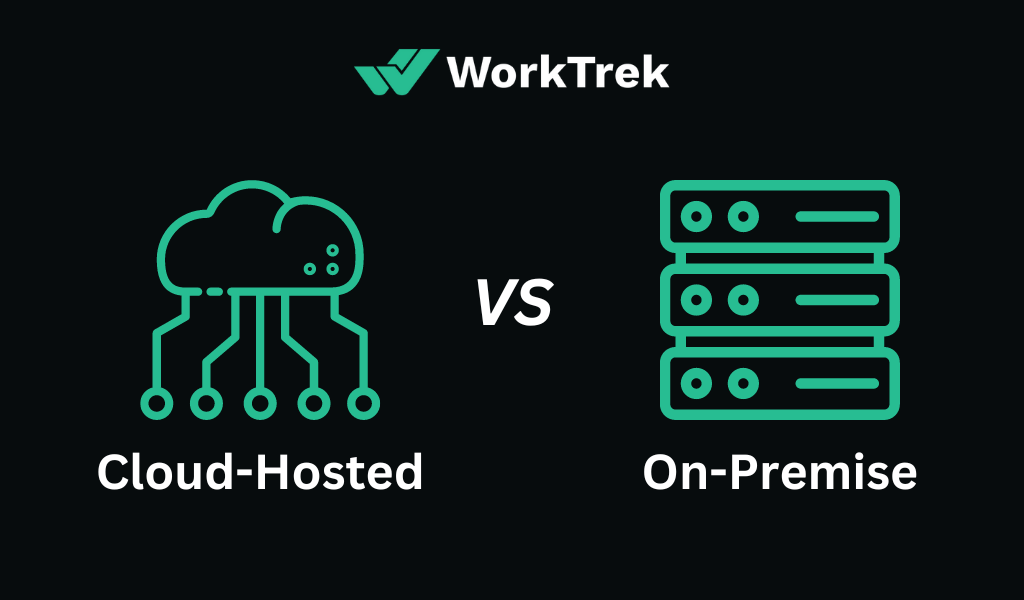Get a Free WorkTrek Demo
Let's show you how WorkTrek can help you optimize your maintenance operation.
Try for freeThe widespread adoption of the cloud has led many vendors to shift their focus from on-premises solutions to cloud delivery models. This raised the question “what is best for my business?“. If you’re wondering which option is more secure, accessible, and affordable, explore our handy comparison.
Comparison Of Cloud And On-Premises Software
Essentially, the fundamental difference between cloud-hosted and on-premise software lies in their location. On-premises software is installed locally, on your company’s computers and servers. In contrast, cloud-hosted software is hosted on the provider’s server and accessed through a web browser.
Besides accessibility, there are many other things to consider when making a decision. These include software ownership, cost of ownership, software updates, and additional services, such as support and implementation. In the next few lines, we explore all the pros and cons of these two different solutions.
Cloud-Hosted Software
With cloud computing and SaaS, users now have other options for using software: instead of purchasing the program once, installing it on their PC, and using it, you can opt for a subscription principle. A supplier thus hosts the software in a data center and gives access to its users. The computer then simply establishes a connection via the browser, and the actual computing power is exercised in a perfectly matched data center. So all you need is internet access.
Not only is the hardware maintained by qualified personnel, but the software is also always kept up to date. Updates are installed without user work and are available immediately. As the software is PC independent, you can access the program from anywhere; you are not limited to your device or location. On the other hand, without Internet access – and this is the big drawback of cloud-based software – nothing works. This can be especially critical for professionals: if the effectiveness of the software struggles due to poor internet connection, you can find yourself in very uncomfortable situations.
Cloud-Hosted Software Cost
Professional on-premise programs can be expensive. It is then not always possible for small businesses and entrepreneurs to make such a large investment. Also, if the business changes and the needs increase, the purchased program may not adapt as quickly as you thought at the time of purchase. With most SaaS providers, on the other hand, users can choose between monthly or annual payments and switch to another product within a relatively short period of time. Additional functions or additional access for employees can be configured easily and often inexpensively.
Opting for cloud-based software means trusting the supplier who offers the program and the control. This relationship of trust is essential because you will certainly be required to transmit sensitive information. These will then be stored in the provider’s data centers. If the cloud program maker does not take data protection seriously, it becomes critical. On the other hand, if the supplier decides (by personal choice or by constraint) to end the offer or to take a break for maintenance work, these stops can have negative consequences for the users.
Cloud Software: Advantages And Disadvantages
Advantages
- Anytime, anywhere access: You can access your apps anytime and anywhere through a web browser from any device.
- Affordable: The cloud requires no upfront cost. In contrast, you make regular payments, making it an operating expense (OpEx). Although the monthly cost adds up over time, maintenance and support services are included, eliminating the need for annual contracts.
- Predictable costs: Enjoy predictable monthly payments covering software licenses, upgrades, support, and daily backups.
- Managed computing: Because the cloud-hosted software is hosted for you, you don’t have to worry about maintaining your software or the hardware it resides on. Compatibility and upgrades are handled by the cloud service provider.
- High levels of security: Data centers use cloud monitoring and employ security measures beyond the means most businesses can afford given increasing observability costs. Therefore, your data is often safer in the cloud than on a server in your offices.
- Rapid deployment: Cloud-hosted software is deployed over the Internet in hours/days. However, on-premises applications must be installed on a physical server and on each PC or laptop.
- Scalability: Cloud technologies offer greater flexibility because you only pay for what you use. Additionally, you can easily scale to meet demand, for example, by adding and reducing licenses.
- Reduced energy costs: When you move to the cloud, you no longer have to pay for electricity to power on-premises servers or maintain their environment. This significantly reduces the amount you pay for your energy bills.
Best Cloud Hosting Services Reviewed by Jayprakash Prajapati
Disadvantages
- Connectivity: Cloud solutions require reliable internet access to keep you productive.
- Long-term costs: Although they require a lower initial investment, cloud applications can be more expensive throughout the life cycle of the system. This increases the total cost of ownership (TCO).
- Less customizable: Cloud-hosted software is generally configurable. But, depending on how it is hosted, a cloud solution may not be able to cope with complex development.
On-Premise Software
Never change a winning team? Many users have been accustomed to the software in their computer systems for decades and have never had any problems with it. You buy a product, then install it on your personal computer, and then use it for many years. The advantage here lies in the possession of the software: once the product has been purchased, it can be used indefinitely. The costs are therefore one-off. But is it worth it? In business, in particular, we work with licenses. Programs cannot be used for an infinite number of workstations. Under certain circumstances, a separate license must be purchased for each employee – or multiple licenses can be purchased directly as a package. The on-premise solution ends up being expensive.
Good software should be constantly updated. These updates may improve program functions, and software stability or close security gaps. They, therefore, require regular installation by users, which takes time. Especially in large companies, installing updates and patches can be a huge effort. Moreover, these updates are generally not infinite. At some point, software publishers may stop developing the software to develop a new product. You then have two options: either you continue to work with an outdated version, or you invest in the new product.
However, one big advantage should not be overlooked: all data stays with you. While cloud solutions require information to be transmitted to a remote server in a data center, on-premise software keeps all data with you (unless the software is combined with cloud hosting). As a user of on-premises solutions, you have full control. You always decide for yourself how to use the software.
On-Premise Software: Advantages And Disadvantages
Advantages
- The total cost of ownership: You only pay once for your user licenses. Therefore, an on-premise solution can have a lower total cost of ownership (TCO) than a cloud system.
- Total control: Your data platforms, hardware, and software, belong to you. You decide on system configuration, upgrades, and modifications.
- Availability: With on-premises systems, you don’t need an internet connection or external factors to access your software.
Disadvantages
- Large capital expenditure: On-premises systems typically require a large initial purchase. This means that capital expenditure (CapEx) is often required. Additionally, you should include maintenance costs for support and feature upgrades.
- Responsibility for maintenance: With an on-premises system, you are responsible for maintaining server hardware and software, data backups, storage, and disaster recovery. This can be a problem for small businesses that have limited budgets and technical resources.
- Longer implementation time: On-premises implementations take longer due to the time required to complete installations on servers and each individual pc/laptop.
Why Is Cloud-Hosted Better Than On-Premises Software?
Better than on-premises deployment due to its flexibility, reliability, and security, the cloud takes the hassle out of maintaining and updating systems. Cloud-Hosted allows you to invest your time, money, and resources in achieving your core business strategies. Also, it provides real-time access to systems and data from a variety of devices, regardless of location. Cloud-Hosted also offers a guaranteed 99% uptime. In 2018, the cloud became the number one choice for UK businesses, with adoption rates reaching 88%.
What Is Best For My Business?
There is no right or wrong solution to the dilemma between cloud-hosted and on-premises software. Each customer is different and has different requirements that will influence the choice of deployment strategy. However, there are a host of questions you will need to ask yourself before finalizing your decision between cloud software and on-premises software:
- CapEx vs. OpEx: Can you afford the initial investment required in an on-premises solution?
- Backup and disaster recovery: Do you have the tools you need to ensure high-level security?
- The Upgrade Cycle: How important is it to you to have access to the latest feature and compatibility updates?















